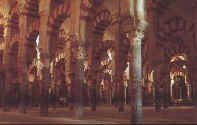CLUAS in Andalucia (page 2 of 3)
From Granada the road lead to C?doba. The route passed through 100 rolling kilometres of hypnotising silver and green olive groves that, according to the authority that is the Lonely Planet, produce one tenth of the world's olives. The hypnotic trance was interrupted for refreshment in (what seemed to be) the Spanish equivalent of a sraid baile. It was a surprise however walking in to its smoky bar to be assaulted by the sounds of Van Halen and Guns’n’Roses and to feel the curious stares from the locals. Hoping I wasn't going to look out of place I attempted to confidently take a seat at the bar and order, in something that vaguely resembled the local tongue, a drink with a Bocadillo con Queso. My linguistic courage, for some unfounded reason, started to grow and I proceeded to try and cut some conversation with the barman. Not a good idea as very soon Cluas found itself with a figurative greasy lump of egg on its face and, for good measure, an olive up each nostril. See, I tried to ask the bemused barman if a slim plastic tube containing yellow fluid behind the bar was one of those fluorescent things the punters swung in the air at some point in the opening ceremony in the Barcelona Olympics (don't ask). However, leaning forward during my interrogation, the delicate equilibrium required to keep me vertical on the stool was spectacularly lost. I went flying, a desperate clutch for the counter to regain balance sent the drinks for a spin and those Bocadillos? They never stood a chance, meeting an early death among the hubris of the unswept floor. I too felt that an early death would be a good idea but instead settled for a quick getaway.
After the trauma of the olive groves and their hamlets, C?doba, the former capital of Muslim Spain, was a welcome sight on the horizon. Sitting on the banks of the Guadalquivir, this turned out to be fascinating and rewarding town to visit. Sure, on the first afternoon I managed to find a fantastic second-hand vinyl store where I picked up the 1984 12" of ‘What difference does it make’, the Associate’s LP ‘Perhaps’ - both for 3 quid - and the original pressing of Dana’s ‘All kinds of everything’ for 50p. The city had already begun to win my heart over.
I soon remembered that C?odba is also home to the Mezquita, one of the most magnificent and revered Islamic buildings. Sensitive to the possibility of being touted as a Philistine on my return, I succeeded in tearing myself away from the record racks to check out the historical wares of C?odba.
 Originally constructed as a Mosque,
the Mezquita is an astonishing construction, distinguished by row after row of
two-tier arches that are assembled with simple strips of red brick and white stone. The
highlight of the Mezquita however has to be the splendid mahrib (prayer niche). Standing
in view of this rich and mesmerising Byzantine flower-motif mosaic turns out to be in fact
a rather frustrating experience. Lens after lens would appeared at my left and right
shoulders for a second before the familiar click and whizz would herald the departure of
the camera to allow its owner, apparently on auto-pilot, to immediately move to the next
photo opportunity. This crowd seemed to on a perpetual tour of 'point, focus, shoot and
move on'. None seemed too concerned with pausing for a moment to reflect on the
magnificence of it all. Maybe I was too kind above in part one.
Mass-tourism sheep are indeed a curious breed.
Originally constructed as a Mosque,
the Mezquita is an astonishing construction, distinguished by row after row of
two-tier arches that are assembled with simple strips of red brick and white stone. The
highlight of the Mezquita however has to be the splendid mahrib (prayer niche). Standing
in view of this rich and mesmerising Byzantine flower-motif mosaic turns out to be in fact
a rather frustrating experience. Lens after lens would appeared at my left and right
shoulders for a second before the familiar click and whizz would herald the departure of
the camera to allow its owner, apparently on auto-pilot, to immediately move to the next
photo opportunity. This crowd seemed to on a perpetual tour of 'point, focus, shoot and
move on'. None seemed too concerned with pausing for a moment to reflect on the
magnificence of it all. Maybe I was too kind above in part one.
Mass-tourism sheep are indeed a curious breed.
With the ascendancy of Catholicism over Islam in the region, the heart of the Mezquita was ripped out in the 16th Century to allow the construction of a Cathedral. Today this cathedral stands an arrogant violation of the haunting beauty of the Islamic architecture that surrounds it. When I first stumbled upon it had the air of a Gothic spaceship that had crash-landed in the center of the original mosque. Any architectural flourishes in the Cathedral are blatantly shown up by the powerful simplicity of the original building.
An unexpected delight of this town was to discover that it is home to the Andalucian equivalent of Jury’s Cabaret. Directly opposite the entrance to the Mezquita lies the Tablao Cardenal, home to an ‘authentic’ flamenco show specially laid on for the camera-toting occupants of our friends, the tour buses. The equivalent of ?13 admits you to an (unmissable!) evening of the locals pulling a fast one on the unassuming. They have my respect.
Walking into the hall the first thing to strike you is the chairs. They are the same
size as the classroom chairs when you started primary school. So, taking a deep breath, I
scooped down and maneuvered my rear-end into its seat and joined the rest of the Northern
Europeans in allowing my knees to tickle my chin. Settled into my piece of dollhouse
furniture I looked up at the stage which now looked ridiculously high. Indeed when the
dancers came on there was not a chance of seeing their feet which, giving them the benefit
of my doubt, I am sure moved delightfully. We were reminded at regular intervals that our
dancers were ‘National Champions’. Our Flamenco guitar player was also one of
Spain’s ‘most renowned’. Maybe so, but would figures of such stature really
be doing a gig in front of 50 pairs of sunburnt northern European knees? Nonetheless, an
apparently Michael Flatley inspired dancer gave it socks. With flowing locks, crotch
suffocating black pants and raunching solos he had the female half of the tour bus
audience swooning in their bloomers.
<< Go back to part 1
>> Continue with part 3
